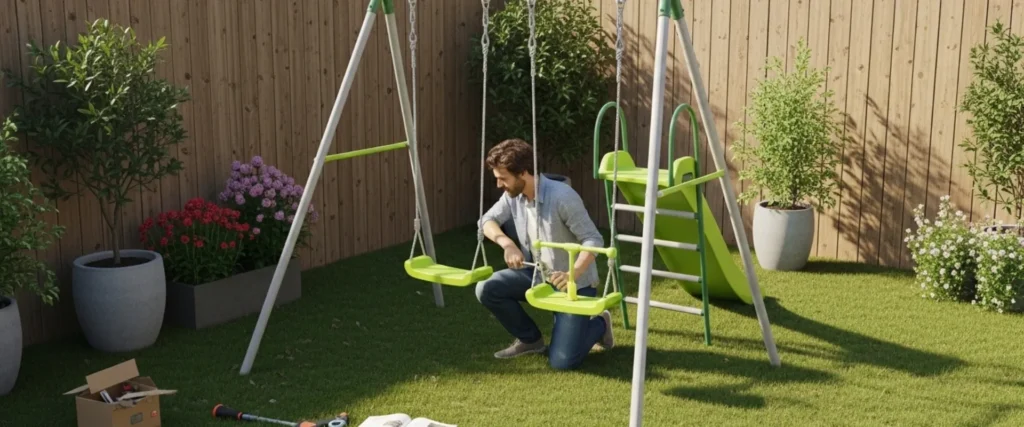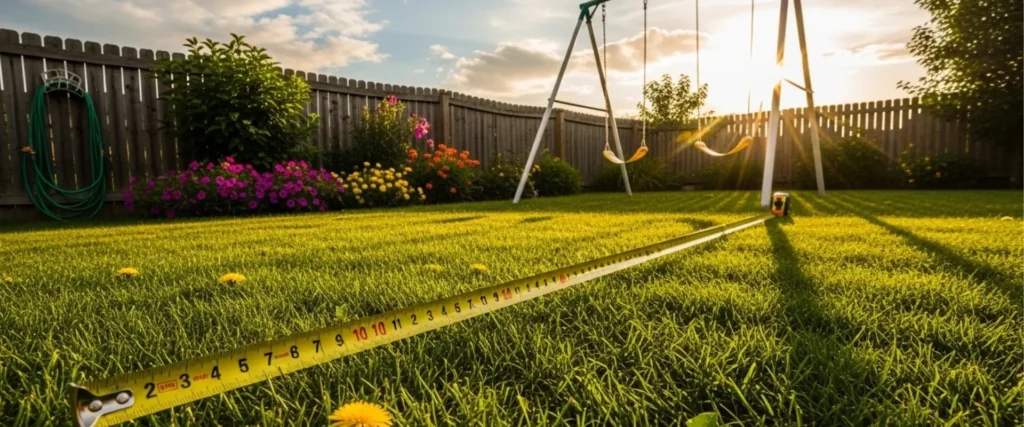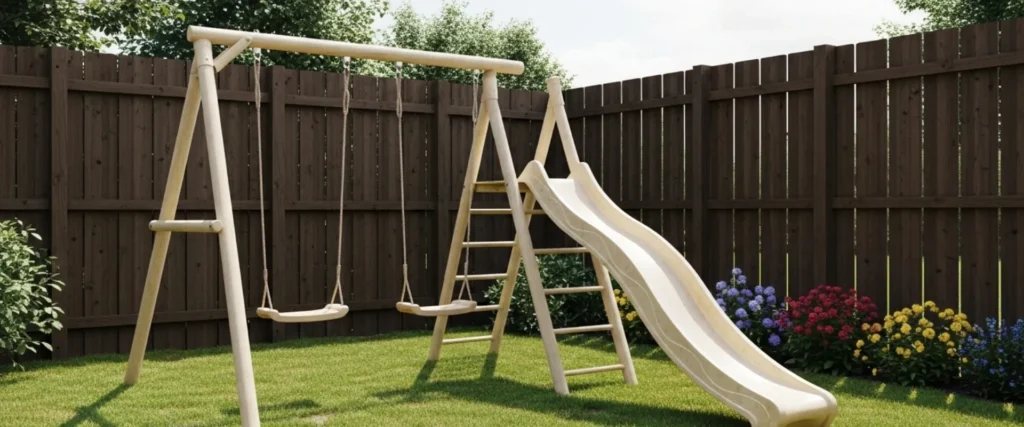Finding the perfect swing set sizes for small backyard spaces can feel overwhelming. Many families assume they need a large yard to give their children a quality play experience, but that’s simply not true. With proper planning and the right size considerations, you can create an amazing backyard playground that fits your space perfectly.
At Wood Kingdom West, we’ve helped Long Island families maximize their outdoor spaces for over 35 years. Whether you have a tiny urban backyard or a modest suburban lot, there’s always a swing set solution that works. This guide will walk you through everything you need to know about choosing the right swing set size for your small backyard.
Understanding Your Small Backyard Space
Before exploring swing set options, you need to measure and assess your available space. Small backyards typically range from 600 to 1,200 square feet, but even smaller spaces can accommodate the right playset.
Start by measuring your backyard’s length and width, and noting any obstacles like trees, fences, or garden beds. Remember that swing sets need safety clearances on all sides. The Consumer Product Safety Commission recommends at least 6 feet of clearance around all equipment, though some manufacturers suggest even more space for certain components.
Key Measurements to Consider
Your swing set placement should account for both the structure’s footprint and the required safety zones. A typical small yard playset might measure 8×12 feet, but you’ll need additional space for safe swinging and sliding activities.
Consider the swing arc when calculating space requirements. Swings need approximately 24 feet of clearance from the support beam to any obstacle in front and behind. Side-to-side clearance should be at least 6 feet on each side of the swing set.
Swing Set Sizes for Small Backyard
Small yard playsets come in various configurations designed specifically for space-conscious families. These compact options maximize fun while minimizing the footprint.
1. A-Frame Swing Sets
A-frame designs are perfect for narrow backyards. These structures typically measure 8-10 feet wide and can accommodate 2-3 swings. Their triangular shape provides excellent stability while using minimal ground space.
Many A-frame swing sets include additional features like trapeze bars or climbing ropes without significantly increasing the footprint. This design works particularly well for long, narrow yards where width is limited.
2. Tower Playsets with Vertical Design
Tower-style playsets build upward rather than outward, making them ideal swing set options for small backyards. These structures typically feature a central tower with a slide, climbing wall, and swing attachment points.
A compact tower playset might measure just 10×8 feet at the base but provide multiple play activities. The vertical design maximizes play value while conserving precious backyard real estate.
3. Modular Swing Systems
Modular systems allow you to start small and expand later if you move or gain more space. Begin with a basic swing frame and add components like slides, climbing features, or additional swings as space and budget allow.
This approach is particularly smart for growing families or those unsure about their long-term space needs. You can customize the configuration to fit your exact measurements and play preferences.


Swing Set Placement Tips for Maximum Efficiency
Strategic placement can make a small backyard feel larger while ensuring safe play. Consider these swing set placement tips when planning your installation.
1. Corner Positioning
Placing your swing set in a corner can save significant space by utilizing fence lines for partial clearance boundaries. This positioning works especially well for L-shaped or triangular swing sets designed to fit corner installations.
Corner placement also creates a defined play area that doesn’t interfere with other backyard activities like gardening or entertaining. The remaining yard space feels more open and usable.
2. Parallel to Property Lines
Installing your swing set parallel to your longest property line can maximize the feeling of spaciousness. This orientation works particularly well in rectangular yards where you want to maintain an open central area.
Consider how this placement affects sight lines from your house. You’ll want to maintain good visibility of the play area from key windows or outdoor living spaces.
3. Integration with Landscaping
Smart landscaping can make your small backyard feel larger while incorporating the swing set naturally into the overall design. Consider using the area under and around the playset for attractive, low-maintenance groundcover.
Proper drainage around the swing set is essential, especially in small yards where water runoff is limited. Ensure the installation area slopes away from the structure to prevent water accumulation.


Safety Considerations in Compact Spaces
Safety becomes even more critical when working with limited space. Every inch counts, so you can’t compromise on essential clearances and safety features.
1. Clearance Requirements
Even in small backyards, safety clearances cannot be reduced. The 6-foot minimum clearance around all equipment is non-negotiable. For swings, you need 24 feet of clearance in the swing path direction.
If your space can’t accommodate these clearances, consider alternative play equipment like a climbing dome or sandbox that requires less clearance space.
2. Surface Materials
Proper safety surfacing is crucial in small spaces where children are more likely to play close to obstacles. Rubber mulch, engineered wood chips, or rubber mats all provide excellent impact protection in compact areas.
The safety surface should extend at least 6 feet in all directions from the play equipment. In tight spaces, this surfacing might cover most of your play area, which actually creates a cohesive, defined play zone.
3. Age-Appropriate Sizing
Choose equipment scaled appropriately for your children’s ages. Smaller children need less space for safe play, allowing you to maximize the play value in your available area.
Consider the long-term growth of your children when selecting features. A swing set that works perfectly for toddlers might feel cramped as children grow larger and more active.


Backyard Swing Set Ideas for Small Spaces
Creative design solutions can help you maximize play value in minimal space. These backyard swing set ideas prove that small doesn’t mean boring.
1. Multi-Level Designs
Multi-level playsets create more play space by building upward. A two-story design might include a ground-level sandbox or playhouse with an upper deck featuring swings and a slide.
This vertical approach can double your play space without increasing the ground footprint. Children love the adventure of climbing between levels, and parents appreciate the space efficiency.
2. Combination Play Structures
Look for swing sets that combine multiple activities in one compact footprint. A structure might include swings, a slide, a climbing wall, and a sandbox, all integrated into a single unit.
These combination structures eliminate the need for separate play equipment, leaving more open space in your small backyard for other activities.
3. Seasonal and Removable Components
Consider swing sets with removable or seasonal components that can be stored when not in use. Swings can be unhooked and stored during winter, and some accessories can be removed to create more space for other activities.
This flexibility allows you to adapt your play space throughout the year and for different types of family gatherings or yard work.
Professional Installation and Customization Services
Professional installation ensures your swing set is safe, level, and properly positioned in your small space. Wood Kingdom West offers expert installation services throughout Long Island, helping families maximize their backyard potential safely and efficiently.
Our experienced team can assess your specific space constraints and recommend the best placement and configuration for your needs. We understand local soil conditions, drainage requirements, and safety regulations that affect small backyard installations.
Custom modifications can help standard swing sets fit unique space requirements. Our team can adjust heights, modify clearances where safely possible, or recommend alternative configurations that work better in tight spaces.
Transform Your Small Backyard into a Play Paradise
Small backyards don’t have to limit your family’s outdoor fun. With careful planning, smart product selection, and professional guidance, you can create an amazing play space that your children will love for years to come.
Ready to explore swing set options for your small backyard? Contact Wood Kingdom West today to schedule a consultation with our experienced team. We’ll help you find the perfect solution that maximizes fun while fitting your space perfectly.
Frequently Asked Questions
What’s the smallest space needed for a swing set?
The minimum space for a basic swing set is approximately 20 x 30 feet, including required safety clearances. This accommodates a simple A-frame swing with two swings and proper clearance zones.
Can I install a swing set on a slope?
Yes, but slopes require professional assessment and potentially more complex installation. Steep slopes may need leveling or terracing to create a safe, stable installation area.
How do I maintain a swing set in a small backyard?
Regular inspections are easier in small spaces since everything is visible and accessible. Check hardware monthly, maintain safety surfacing, and keep vegetation trimmed away from play areas.
Are there swing sets designed specifically for small yards?
Yes, many manufacturers offer compact or small-yard specific designs. These prioritize vertical play space and efficient footprints while maintaining safety standards.
What’s the best surface material for small backyard swing sets?
Rubber mulch or rubber mats work well in small spaces because they’re easy to contain and maintain. They also provide excellent safety protection in areas where space is limited.

